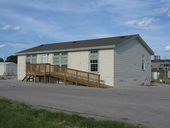Highlight
UTest House becomes a Focal Point for IGERT Education and Research
Achievement/Results
Trainees and affiliates of the National Science Foundation’s (NSF) Integrative Graduate Education and Research Traineeship (IGERT) program in Indoor Environmental Science and Engineering at The University of Texas (UT) are benefiitting from a unique test house facility made possible by IGERT funding. The UTest House is a fully instrumented 1300 ft2 manufactured home used for education and research in indoor environmental science and engineering. The UTest house has seven building rooms/zones and two heating ventilation and air-conditioning (HVAC) systems, one for the ceiling and a second for floor air distribution. While there are several test houses in United States, none of them is equipped to perform such detailed monitoring of indoor air quality and energy performance as is possible with the UTest house.
The equipment at the heart of the building performance measuring apparatus is permanently installed in the house and includes: (1) continuous monitoring of outdoor air infiltration, (2) air and contaminant flow between building rooms/zones, (3) temperature and relative humidity measurements at numerous points throughout the house, (4) energy monitoring of the two HVAC systems and their components, (5) weather parameters monitoring in the vicinity of the test house, (6) air and wind velocity and turbulence measurements inside and outside of house, and (7) pressure measurement on the building facades and in different rooms/zones of the house.
Besides the stationary equipment, the UTest house is equipped with numerous portable instruments for assessment of: indoor air quality, material emissions, and indoor air and surface chemistry. These include various particle generation systems and particle concentration monitors for the particle range from 10 nm to 10 µm. The UTest house is also equipped with automatic air sampling systems for reactive and noncreative gases emitted from various building materials and portable ozone generation systems with multiple ozone monitors. To simulate heat and moisture generation by occupants, the UTest house is equipped with systems of heaters and steam humidifiers with timers. These systems are distributed around the house to simulate human body impacts on indoor air flows and building energy consumption. Almost all measuring systems are remotely controlled from IGERT student and faculty offices. A virtual interface enables the real-time monitoring of experiments and provides IGERT students and faculty with the ability to control experiments without being in the house.
The UTest house and measuring systems were assembled under the guidance of IGERT faculty participant Atila Novoselac in the spring of 2008, with contributions from all IGERT trainees and many IGERT affiliates. During the past year it has been used for multiple IGERT courses and research projects. The UTest house was used in three courses: Indoor Air Quality: Field Measurements, Design of Energy Efficient and Healthy Buildings, and HVAC Design. In these courses graduate and undergraduate students used the UTest house to learn about experimental research methods and to explore fundamental engineering phenomena in a realistic residential setting. Also, more than a half dozen IGERT trainees and affiliates have been using the UTest house for their research projects.
These projects include: 1) Passive reduction of human exposure to indoor ozone. This project investigates energy efficient methods for indoor ozone removal by use of activated carbon and unpainted gypsum wallboard panels. Experiments in the test house have been used for development of ozone transport models in indoor residence with airflow driven by natural and forced convection.
2) Impact of placement of portable air cleaning devices in multizone residential environments. This project investigates variations in the overall particle removal and human exposure reduction for different positions of portable cleaning device in a residence. The test house was used for development and validation of computational fluid dynamics (CFD) models used in this study.
3) Energy implications of filtration in residential buildings. This project explores the effects of high, medium and low efficiency filters on energy consumption in residential buildings. As a part of this project, energy consumption in various components of HVAC systems in the UTest house was monitored with different filters over a period of 10 months.
4) Transport of contaminants between indoor and outdoor environment. The focus of this project is on the effects that natural ventilation has on transport of particulate matter between indoor and outdoor environments and human exposure to particulate contaminants. The experiments included measurements of indoor and outdoor airflow, turbulence fluctuation and pressure distribution, with data used for development of airflow models.
5) Biological and metal contaminants in HVAC filter dust. This research focuses on microbial contaminants and metals captured on HVAC filters of residential buildings. Correlations are being developed between the concentrations of these contaminants in dust samples collected at various positions in the house and in the filter mass. The UTest house was used for experimental methods development and as one of seventeen experimental sites.
Address Goals
The UTest house is a very important piece of infrastructure that was purchased with first-year IGERT funds. It has quickly evolved into a focal point of our IGERT program, and will likely continue its valuable educational and research roles long into the future. In just one year it has been employed for several experimental studies, some of which involve external funding that would not have been possible without the existence of the UTest house.
The UTest house also facilitates discovery, by allowing IGERT students and faculty to engage in research within one of the most well-equipped test house facilities in the world. For example, the UTest house was recently used to quantify the extent to which activated carbon affixed to overhead fan blades can increase ozone removal in a full-scale house.











